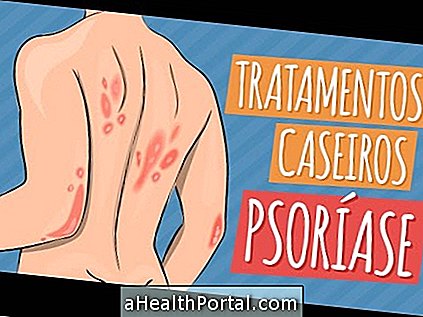The child who has difficulty eating certain foods such as meat, fruits, vegetables, having a very selective food, always eating the same, may have a psychological disorder and need psychologist-oriented treatment.
It is normal for a child to have a decreased appetite by age 2, however, certain children may experience eating disorders by choosing to eat only porridge, soup, puree, or rice with beans and shredded meat, for example, by not accepting any another type of meal. This is cause for concern when it remains in childhood, being present even at 3, 4, 5, 6 ... years. And in that case, parents should seek professional help.

When to go to the doctor
In cases where signs and symptoms of an eating disorder are evident, it is best to seek medical help that is evaluated, and it is very likely that other professionals such as the psychologist should be approached to perform a cognitive behavioral therapy that offers the tools for the child work your thoughts and actions.
This behavioral therapy is called systematic desensitization, where the child is asked to write down what their daily food is like, and asks for a list of foods they would like to try someday, and when they can try some new food, they are rewarded. For children suffering from anxiety is taught how to relax when they are ahead of a new food, creating stories and stories before eating them so they can imagine themselves eating their food in a relaxed manner.
In addition, it may also be necessary to seek an occupational therapist to apply a therapy called the Wilbarger Protocol in the mouth, where sensory integration is performed using techniques that may include the use of a toothbrush, for example.
An appointment with a dietitian is also indicated due to the restriction of food that can cause malnutrition and an individualized nutritional plan with the possibility of using formula supplements to provide the calories your body needs.

What Eating Disorders May Exist in Childhood
Although not very common, there are some eating disorders that can cause a child to eat only a certain type of food, such as puree or porridge, at a specific temperature. Are they:
1. Restrictive or selective feeding disorder
This is a type of eating disorder that usually arises in childhood or adolescence but can also arise or persist in adulthood. In this disorder the child limits the amount of food or avoids its consumption based on its experience, color, aroma, taste, texture and presentation.
The main signs and symptoms of this disorder are:
- Major weight loss or difficulty reaching the ideal weight, according to your age;
- Only eat certain textures of food;
- Restriction of the type and amount of food ingested;
- Lack of appetite and lack of interest in food;
- Food selection too restrictive, which can get worse over time;
- There is no change in body image or fear of gaining weight as occurs in anorexia;
- Fear of eating after an episode of vomiting or choking;
- Presence of gastrointestinal symptoms such as stomach upset, constipation or abdominal pain.
These children tend to have relationship problems with other people because of their eating problems and may have significant nutritional deficiencies that affect their growth and development as well as their school performance.
Learn more details of this eating disorder here.
2. Disorder of sensory processing
This disorder is a neurological condition where the brain has problems receiving and responding properly to information that comes from the senses like touch, taste, smell or vision. The child can be affected in only one or several senses, and therefore a person with this disorder can respond exaggeratedly to a stimulus, being unbearable sound, clothing, physical contact, light and even food.
When the taste is affection the child can present:
- Oral Hypersensitivity
In this case the child has extreme food preferences, with a very small food variation, can be picky with brands, resist trying new foods in restaurants and can not eat at other people's houses, avoiding spicy, salads.
It is possible that you only eat foods of a soft, pure or liquid consistency after 2 years of age, and may surprise food with other textures. You may also have trouble sucking, chewing or swallowing for fear of choking. And you can resist or resort to going to the dentist, complaining about the use of toothpaste and mouthwash.
- Oral hyposensitivity
In this situation the child may prefer foods with intense flavor such as overly spicy, sweet, bittersweet or salad, even feeling that the food does not have enough seasoning. And you can say that all foods have the 'same taste'.
It is also possible that you chew, taste, or lick inedible objects, often eating your hair, shirt or fingers. Unlike oral hypersensitivity, you may like electric toothbrushes, like going to the dentist and drooling excessively.
What to do to make your child eat everything

Some practical advice to make your child eat a greater variety of foods or in greater quantity, are:
- Offer new foods preferably when the child is hungry, because they will be better accepted;
- In order for the child to accept new foods one should try to eat them, not giving up before trying about 8 to 10 times, on different days;
- Combine preferred foods with the least accepted;
- The child usually eats better if they choose some food from the meal, at least 2;
- Avoid having your child drink plenty of fluids immediately before meals;
- The time to eat should not be less than 20 minutes and longer than 30 minutes, long enough for the child to recognize the sensation of satiety of his body;
- If the child does not want to eat, it should not be punished, because this reinforces the negative behavior, one should remove the dish and it can leave the table, but the next meal should offer a nutritious diet;
- It is important that the child and family are seated at the table, quietly, and it is important to have fixed times for meals;
- Take the child to buy food on the market and help in the choice and preparation of meals and how it is served;
- Read stories and stories about food.
In cases where there is evidence of a disorder it is possible that the process of regulating feeding takes weeks, months, and sometimes years of treatment before your child can enjoy food in a 'normal' way, have adequate food and adapt, being very important to seek help from health professionals, such as pediatrician and psychologist, for these situations.






















